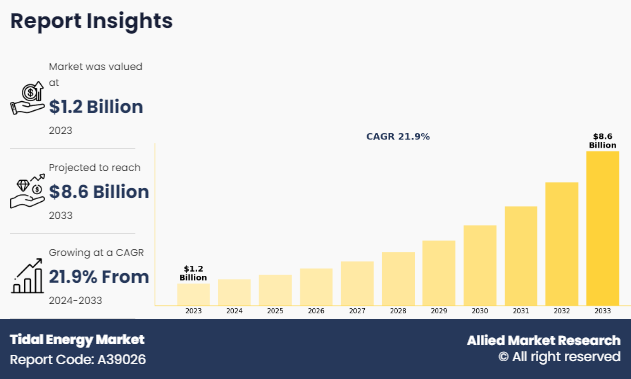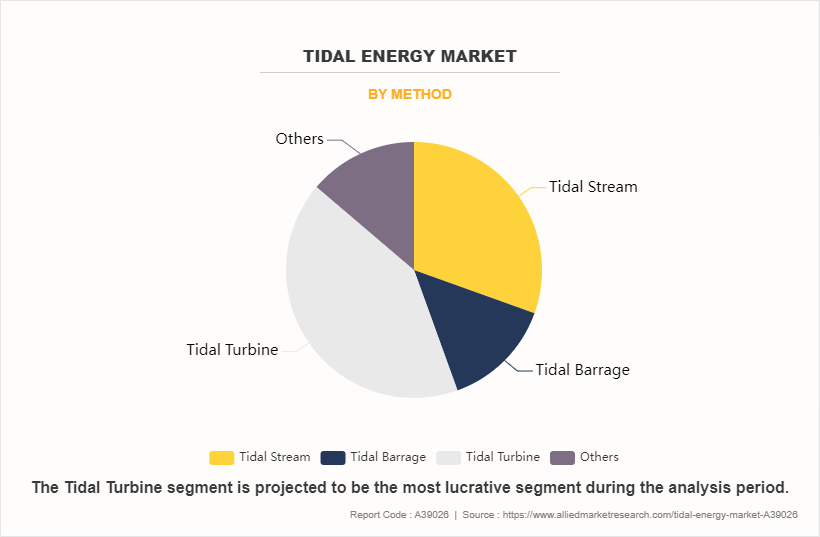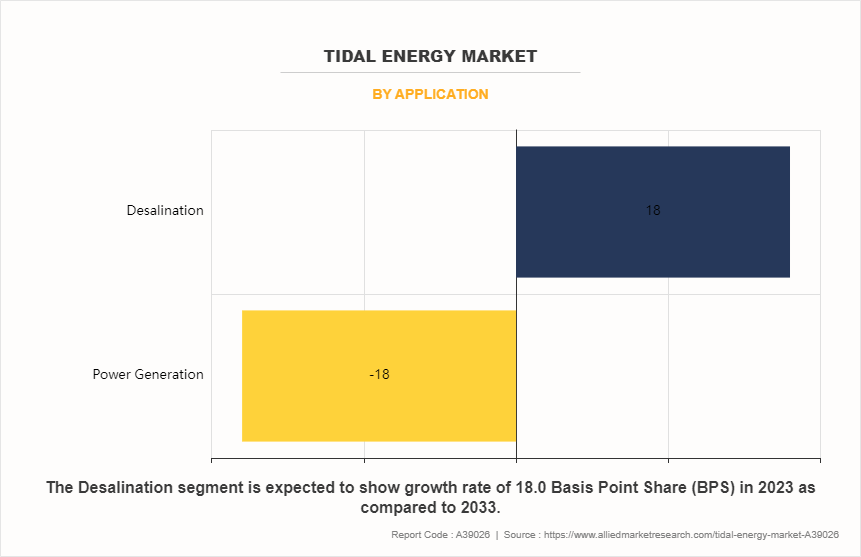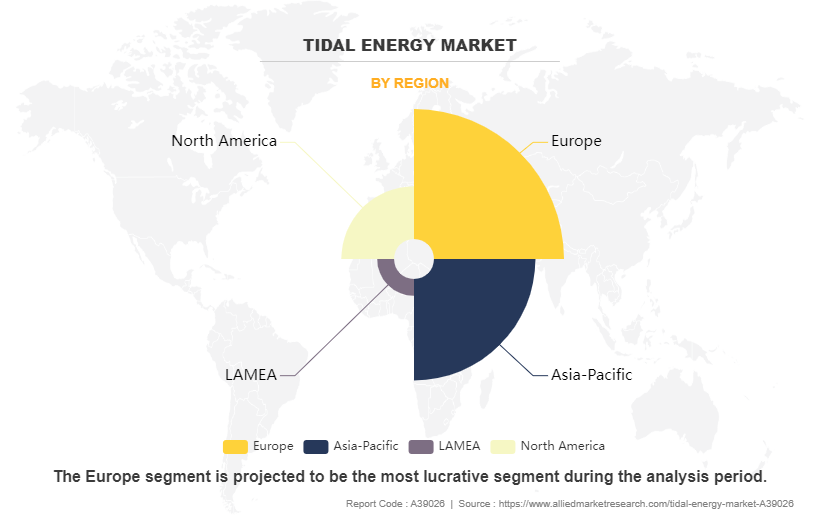Tidal Energy Market Research, 2033
The global tidal energy market was valued at $1.2 billion in 2023, and is projected to reach $8.6 billion by 2033, growing at a CAGR of 21.9% from 2024 to 2033. The global tidal energy market is experiencing growth due to several factors such as a rise in demand for renewable energy resources, and advancement in tidal power generation equipment. However, the presence of alternatives such as solar and wind power generation limits the market expansion. However, the presence of demand in the energy sector for sustainable power generation resources and government initiatives to invest in tidal energy development provides lucrative opportunities for tidal energy market growth.

Introduction
Tidal energy, also known as tidal power, is a form of renewable energy derived from the gravitational forces between the Earth, the Moon, and the Sun. It primarily harnesses the kinetic energy of the Earth's oceans, generated by the gravitational pull of the Moon and the Sun, causing the tides to rise and fall regularly. Tidal energy can be captured through two methods such as tidal stream systems, which use underwater turbines to capture kinetic energy from water movement, and tidal barrage systems, which build sluice gates across estuaries or basins to allow water to flow in and out, driving turbines and generating electricity.
Key Takeaways
- The global tidal energy market is highly fragmented, with several players including European Marine Energy Centre, Andritz AG, Orbital Marine Power Ltd., Sustainable Marine Energy Ltd., Nova Innovation Ltd., SIMEC Atlantis Energy Ltd, HydroQuest SAS, Verdant Power Inc., Hammerfest Strom AS, and Minesto AB.
- More than 6,765 product literatures, industry releases, annual reports, and other such documents of major industry participants along with authentic industry journals, trade associations' releases, and government websites have been reviewed for generating high-value industry insights.
- The study covers more than 20 countries across the globe in terms of value and volume during the period 2024-2033 of the tidal energy market forecast is covered in the report.
Market Dynamics
The growing global demand for renewable energy sources has significantly propelled interest in the tidal energy market. With increasing concerns about climate change and environmental sustainability, there is a pressing need to transition away from fossil fuels. Tidal energy presents a promising solution due to its reliability and predictability, driven by the gravitational forces of the moon and the sun. As governments and corporations seek to meet renewable energy targets and reduce carbon emissions, the demand for tidal energy technologies continues to rise, driving innovation and investment in the sector.
Despite its potential, the tidal energy market faces significant challenges, primarily associated with high initial costs. The development and installation of tidal energy systems require substantial investment in infrastructure, technology, and site assessment. The complex nature of tidal energy projects often involves high capital expenditures, including the construction of turbines, underwater cables, and support structures. In addition, the harsh marine environment adds to operational and maintenance expenses. These cost barriers hinder the widespread adoption of tidal energy and pose challenges for project developers and investors, slowing the market's growth trajectory.
In the tidal energy market, ongoing innovation and research present significant opportunities for advancement and expansion. As the industry matures, technological advancements are driving improvements in the efficiency, reliability, and cost-effectiveness of tidal energy systems. Research efforts focus on optimizing turbine designs, enhancing resource assessment methodologies, and developing innovative installation and maintenance techniques. Moreover, collaboration between academia, industry, and government entities fosters knowledge exchange and accelerates technological breakthroughs. With increasing investment in research and development, the tidal energy sector is expected to overcome challenges and unlock its full potential as a viable renewable energy source.
Research and development (R&D) efforts in ocean energy technologies have seen significant support and advancements in recent years. In 2022, the U.S. Department of Energy's Water Power Technologies Office (WPTO) notably funded six wave energy technologies for open-water testing, marking a record level of support. In addition, numerous universities, private companies, organizations, and national laboratories are actively involved in ocean energy research, collectively offering approximately 40 unique testing facilities. To further foster research, education, and outreach, WPTO has established four National Marine Renewable Energy Centers in collaboration with nine universities. These centers play a crucial role in advancing ocean energy technologies by providing research infrastructure and expertise. Moreover, DOE's national laboratories, such as the National Renewable Energy Laboratory (NREL) and Sandia National Laboratories, possess unique testing instrumentation and facilities to address complex R&D challenges in ocean energy and hydropower. Furthermore, international collaborations, such as the International Energy Agency-Ocean Energy Systems Task 4 Working Group, focus on assessing environmental effects and monitoring efforts for ocean energy deployments. One notable accomplishment in environmental monitoring is the successful deployment of acoustic monitoring sensors alongside wave energy devices, ensuring minimal impact on marine wildlife and ecosystems.
Segments Overview
The tidal energy market is segmented into method, application, and region. On the basis of method, the market is divided into tidal stream, tidal barrage, tidal turbine, and tidal fences. On the basis of application, the market is bifurcated into power generation and desalination. On the basis of region, the tidal energy market is analyzed across North America, Europe, Asia-Pacific, and LAMEA. The tidal energy market overview of each segment in the primary segment is explained below.

On the basis of method, the tidal barrage segment dominated the tidal energy market share in 2023. Tidal barrages are a reliable and predictable renewable energy source, harnessing kinetic energy from the predictable movement of tides. They have a high energy density, generating significant power from a small area, making them economically viable for tidal power generation. Tidal barrages have long operational lifespans, reducing operational costs and providing stable investment. They can be easily integrated into existing electrical grids, minimizing transmission losses. Although they have environmental impacts, they offer benefits such as flood control, habitat creation, and improved water quality. Tidal barrage technology's major market share is primarily due to the presence of mature technology, reducing risks and uncertainties of failures in power generation.

On the basis of application, the power generation segment dominated the tidal energy market size in 2023. The presence of demand for renewable power generation and the potential to harness unlimited marine energy have boosted the tidal energy market. In addition, the rapid growth in coastal cities in developed and developing countries across the globe will provide a mature market ecosystem for the development of tidal power plants.

On the basis of region, Europe dominated the tidal energy market in 2023. The presence of major turbine manufacturers in this region has a significant positive impact on the tidal energy market. In Europe region, tidal turbine, and tidal stream-based power generation is widely prevalent due to the presence of wind turbine manufacturing infrastructure, which can be utilized in marine energy equipment manufacturing. The presence of stringent environmental regulations and government incentives to develop marine energy resources to meet the ever-growing energy demand provides ample opportunities for the development of the tidal energy market in this region.
Competitive Analysis
The major players operating in the tidal energy market include European Marine Energy Centre, Andritz AG, Orbital Marine Power Ltd., Sustainable Marine Energy Ltd., Nova Innovation Ltd., SIMEC Atlantis Energy Ltd, HydroQuest SAS, Verdant Power Inc., Hammerfest Strom AS, and Minesto AB.
Recent Developments in Tidal Energy Industry:
- China has made significant strides in the tidal and wave energy sectors, showcasing impressive developments and projects. The LHD tidal current energy project surpassed 60 months of operation time in December 2022. The project was successful with the installation of a new turbine on the grid.
- The Zhoushan Tidal Current Energy Demonstration Project underwent upgrades and commenced operations in 2023. In a diversification move, China inaugurated its first tidal-PV power station at the Jiangxia Tidal Power Station reservoir in 2022, reinforcing its commitment to renewable energy sources.
- The collaborative efforts of companies such as GIEC, China Southern Power Grid, and China Merchants Heavy Industry Company have yielded progress on the Wanshan 1 MW wave energy project, with the successful testing of two 500 kW units near Wanshan, Guangdong Province.
- Sustainable Marine, for instance, is expected to deliver the world's first floating tidal array at the Fundy Ocean Research Centre for Energy (FORCE) site. This ambitious project aims to validate their technology and environmental monitoring systems before scaling up deployments in the Minas Passage. Sustainable Marine has made significant strides in developing an advanced environmental monitoring system and constructing specialized vessels like the Tidal Pioneer, enhancing their capabilities for future high-flow site operations.
- DP Energy plans to deploy Andritz Hammerfest Hydro (AHH) MK1 turbines, boasting a robust design with a seabed-mounted configuration. These turbines, scheduled for deployment at the FORCE site, signify DP Energy's commitment to harnessing tidal energy efficiently.
- Nova Innovation's phased development of a 1.5 MW tidal energy project in Petit Passage, Nova Scotia, showcases a strategic approach to environmental management and technological advancement. By deploying the project in three separate phases, Nova Innovation aims to closely monitor environmental effects while progressively expanding their tidal array. These planned developments underscore the industry's dedication to innovation, sustainability, and the pursuit of clean energy solutions.
Market Incentives
- The Canadian government is taking proactive steps to incentivize the development of clean technologies, including tidal, wave, and river current technologies. In its 2022 Fall Economic Statement, the government introduced a refundable 30% investment tax credit specifically tailored for clean technologies. This tax credit aims to encourage investment in renewable energy projects and accelerate the transition towards a low-carbon economy. The final details of this incentive are expected to be established in 2023, demonstrating the government's commitment to supporting the growth of the clean energy sector.
- Nova Scotia stands out as a leader in Canada by offering targeted market incentives for marine renewable energy projects. Under the province's Marine Renewable Energy Act, projects that receive permits are eligible to secure power purchase agreements (PPAs) for up to 15 years. In addition, Nova Scotia's feed-in tariff (FIT) program provides further support, offering a favorable rate of 53 cents/kWh for approved projects, such as DP Energy's Uisce Tapa Project, Sustainable Marine's Pempa’q Project, and Big Moon Power. These initiatives reflect Nova Scotia's commitment to fostering the growth of marine renewable energy and positioning itself as a hub for clean energy innovation.
Key Benefits For Stakeholders
- This report provides a quantitative analysis of the market segments, current trends, estimations, and dynamics of the tidal energy market analysis from 2023 to 2033 to identify the prevailing tidal energy market opportunities.
- The market research is offered along with information related to key drivers, restraints, and opportunities.
- Porter's five forces analysis highlights the potency of buyers and suppliers to enable stakeholders make profit-oriented business decisions and strengthen their supplier-buyer network.
- In-depth analysis of the tidal energy market segmentation assists to determine the prevailing market opportunities.
- Major countries in each region are mapped according to their revenue contribution to the global market.
- Market player positioning facilitates benchmarking and provides a clear understanding of the present position of the market players.
- The tidal energy market report includes the analysis of the regional as well as global tidal energy market trends, key players, market segments, application areas, and market growth strategies.
Tidal Energy Market Report Highlights
| Aspects | Details |
| Market Size By 2033 | USD 8.6 billion |
| Growth Rate | CAGR of 21.9% |
| Forecast period | 2023 - 2033 |
| Report Pages | 270 |
| By Method |
|
| By Application |
|
| By Region |
|
| Key Market Players | HydroQuest SAS, sustainable marine energy ltd, SIMEC Atlantis Energy, European Marine Energy Centre (EMEC), nova innovation ltd, Andritz AG, Orbital Marine Power Ltd, Hammerfest Strom AS, Verdant Power, Minesto AB |
Analyst Review
The rapid adoption of tidal energy generation is the key factor attributed to the leading position of Europe in the global tidal energy market. The Europe region is further expected to provide lucrative opportunities to leading tidal energy converter product manufacturers, owing to its huge potential to set up manufacturing plants and the surge in demand for electricity from the coastal communities in the region.
Easy and wide availability of tidal energy across the globe is expected to drive the growth of the tidal energy market in the upcoming years. However, high capital investment is the key factor expected to hinder market growth during the forecast period. On the contrary, an increase in government initiatives and investments in the renewable energy sector is anticipated to provide remunerative opportunities for the key players to maintain the pace in the tidal energy market in the upcoming years.
Among the analyzed regions, Asia-Pacific is expected to account for the highest revenue growth rate in the tidal energy market throughout the forecast period, followed by North America, Europe, and LAMEA.
$8.6 billion is the estimated industry size of Tidal Energy market in 2033.
Technological Advancements Cost Reduction Policy and Regulatory Support Pilot Projects and Commercial Deployment Integration with Other Renewable Sources are the upcoming trends of Tidal Energy Market in the world.
Power generation is the leading application of Tidal Energy Market in 2023.
Europe is the largest regional market for Tidal Energy Market in 2023.
European Marine Energy Centre, Andritz AG, Orbital Marine Power Ltd., Sustainable Marine Energy Ltd., Nova Innovation Ltd., SIMEC Atlantis Energy Ltd, HydroQuest SAS, Verdant Power Inc., Hammerfest Strom AS, and Minesto AB are the top companies to hold the market share in Tidal Energy
Loading Table Of Content...
Loading Research Methodology...


